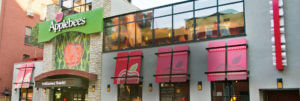Whether you’re opening your first cafe, expanding your eatery to more than one location or renovating an existing establishment, creating the optimal design layout for restaurants should be high on your list of priorities.
No two restaurants are the same, especially between various restaurant categories such as a formal restaurant, casual grill, quick service cafe or family diner. However, certain design layout factors can help to enhance the customer experience and improve the bottom line. Take a look at some initial considerations for an optimal design layout for restaurants.
Planning the Optimal Design Layout for Restaurants

KMB Design Group provided LEED Consulting, Commissioning Support, Mechanical, Electrical, and Plumbing Engineering services for this ground up, 2-story new construction, Applebee’s in New York City.
Opening or renovating a foodservice operation is exciting, but it can also be stressful. We know you have a lot of factors to keep in mind when optimizing your restaurant’s design. Here are five to get you started.
1. Dining Area
The dining area should comprise about 60% of the restaurant layout. This space will vary depending on the type of restaurant in operation. Currently on trend are open-concept restaurant layouts and communal dining experiences. These layouts also work well for smaller spaces.
2. Regulations
When planning a seating space layout for a restaurant, the first step is to check with the local building permit office on any occupancy regulations for your establishment. Review the ADA guidelines for accessibility as well. Being aware of local codes, mechanical, plumbing and electrical connections and other zoning guidelines ahead of time will ensure that the design layout meets applicable regulations. This will not only help a project stay on it’s timeline and budget, but also help to reduce the risk of potential fines.
3. Traffic Flow
When determining the optimal traffic flow, it’s important to address the kitchen floor plan (which can take up to 40% of the restaurant layout space), fire protection elements, restroom location, bar or outdoor seating as well as the waiting area. The design layout should factor in both the customer journey and the employee’s journey for the most efficient and effective operation.
4. Energy Efficiency
Restaurants require a lot of power. In fact, a large amount of a restaurant’s budget could be devoted to energy costs which is why energy efficiency efforts are so important. Many energy challenges must be identified, such as: cooking, water heating, refrigeration, space heating and cooling and even entertainment. For example, the design layout should consider strategically placing cold storage far away from heat sources to keep appliances from working overtime.
5. Air Ventilation
In addition to maximizing energy efficiency, it’s also important to think about indoor air quality. Without proper air ventilation in the kitchen, air quality will suffer. An optimal design layout for restaurants will include floor plans with fans in the kitchen or air purifiers back of house.
KMB Restaurant Design Layout Services
Your establishment has unique needs. Offering engineering support to help create the optimal floor plan for your restaurant, the KMB Facilities & Energy Engineering experts have technical expertise and decades of experience helping foodservice and hospitality businesses.
Whether you need to minimize energy usage at your establishment, improve the look, feel and function of your eatery or take the steps to become LEED certified, KMB has the vast experience, resources and technical skills required to meet your needs.
Contact KMB’s Engineering experts for more information on designing your next restaurant layout.